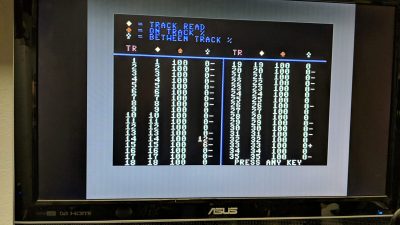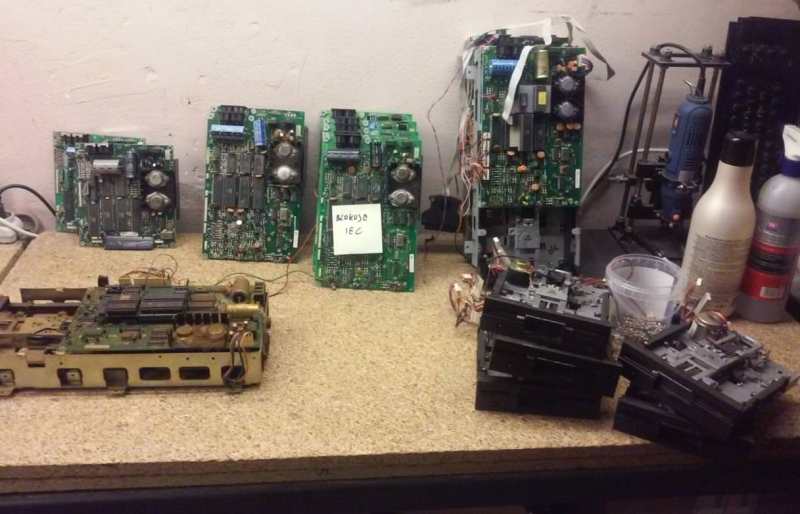One of the best parts of retrocomputing is that you can obtain so many broken systems and peripherals for repairing and other assorted fun. This was the wholesome activity that [Drygol] embarked on recently with a gaggle of Commodore floppy disk drives that he obtained, involving a lot of cleaning, soldering, calibrating and other assorted entertainment. This follows cold on the heels of an earlier repair session of a stash of Commodore 1541 FDDs.

As with any such devices, the first thing to do is to clean the heck out of them, to remove forty-odd years of dust and other debris, followed by testing of functionality, replacing dead ICs and the usual round of (electrolytic) capacitor replacement. Retrobrighting gives it that fresh-out-of-packaging look, which leaves just the calibrating of these drives. This procedure is essential to make sure the read/write head is aligned with the tracks on the disks, and is the most fiddly part of the process.
What helps a lot here is the 1541 diagnostic cartridge by [World of Jani] that displays real-time information on the drive while you are tweaking its speed and head alignment. All you have to do is tweak the speed potentiometer, and adjust the position of the drive motor, which takes a bit of patience and a steady hand. After this repair session a few Mitsumi drives unfortunately remained dead due to busted coils. Despite a valiant repair attempt on the heads by manually rewinding the coils, this remains a topic for a potential part III.

















And if we’re at, let’s fix the drive electronics and install a light barrier for proper track 0 detection.
The 1541-C board supports it by default, if I remember correctly.
So it’s perhaps better to fix this model and use an older one for parts.
Fix the drive electronics and install a light barrier? Care to add any more details?
The normal 1541 doesn’t contain a detection to find out were the floppy head is.
So the firmware bumps the head against the wall during power-on and especially before formatting of a diskette, causing its mis-alignment in the long run (AFAIK).
The 1541C model fixed this issue by using a light barrier connected to a free pin of the floppy drive electronic’s parallel bus. That’s why some C64 owners had removed the light barrier sensor, it had conflicted with the popular parallel cable mod to speed up i/o speed between C64 and 1541.
Here’s a hardware description that I’ve found while googling:
http://www.d81.de/R.I.P/1541C-to-1541II-diff-03.txt
The later 1541-II even reversed the light barrier upgrade, going back to the humble design of the original 1541. But hey, it was very compatible with the hacky C64 software that way.
(It *perhaps* also was possible to use 1541C firmware on 1541/II, but maybe required faking the light barrier’s presence. Not sure, must check.)
It wasn’t until the 1571 that a proper, non-broked floppy drive came out – in my opinion.
Unfortunately, it needed a C128 to run at full i/o speed. The C128D was a great experience, thus. It had both a 1571 and C64 mode built-in, without all the quirks associated with the 1541 series.
I ran into similar issues a few years back when repurposing an old welding robot.
Stop “aligning” disk drives! I repaired over 80 disk drives, and it was all the time either just smudge, oil on head, missing grease on rods, defective head coil, capacitors, ICs, voltage regulator, cable or speed. Never ever was the head misaligned. The only reason a head could be misaligned is if someone tried to “align” it, or it got dropped heavily.
That’s the thing with the 1541 – it literally beat the head mechanism against a hard stop as a way to determine the home or track 0 position. There was a legitimate need to align 1541 drives, but if you’re smart you do it with an analog alignment disk (which are about as common as honest politicians..)
We are in 2024, I am wondering why no one managed to get a complete head coil rewinding guide out there, is it such a feat? With the number of drives that will be thrown away for something that looks like a cool weekend hack project that could give the drives another gemerational usage, I thought some brave soul would have figured it out by now, or maybe I just missed it :)